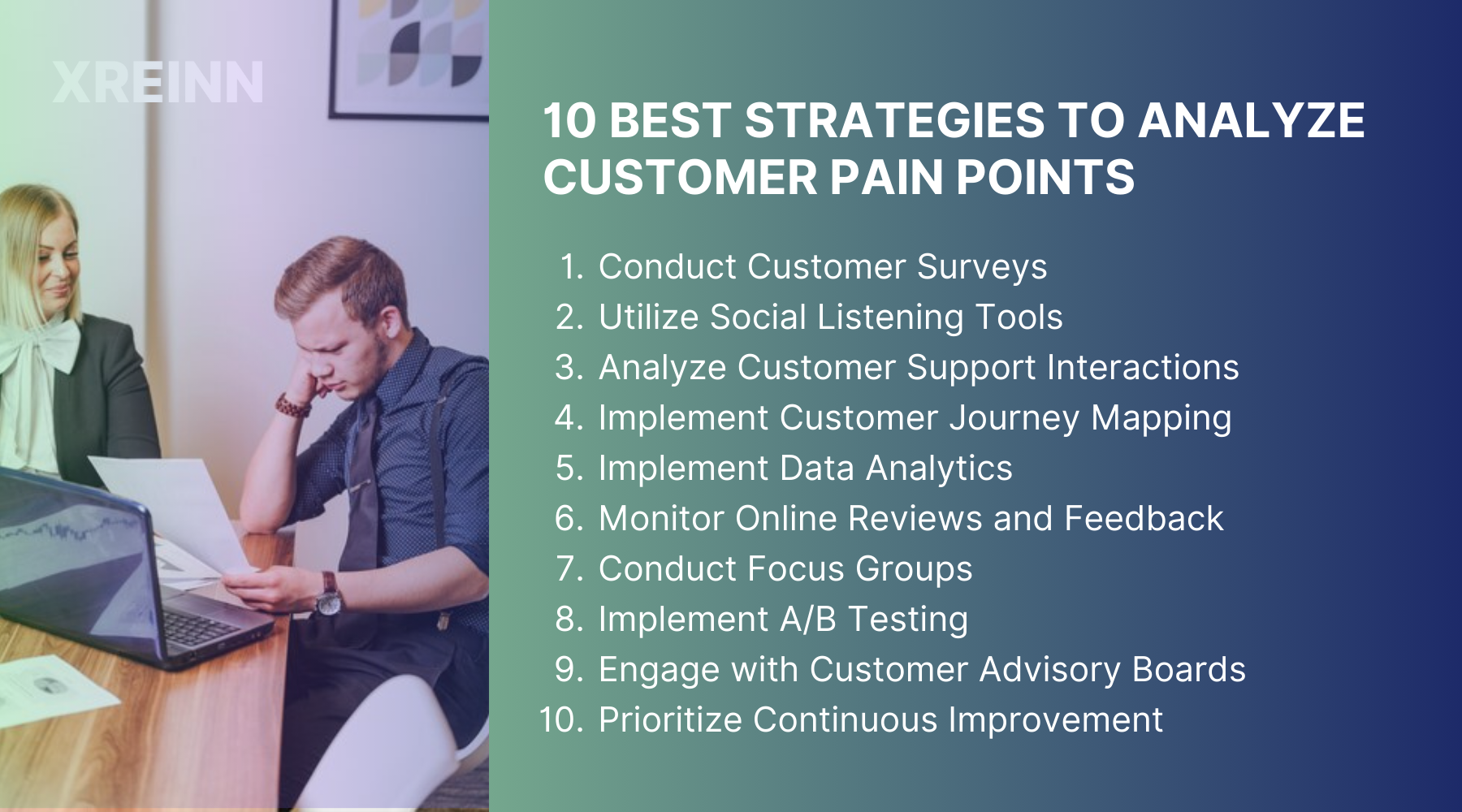Social Listening
10 Best Strategies to Analyze and Resolve Customer Pain Points
Jul 01, 2024
To build a successful business, it's essential to deeply understand what resonates with your customers. This requires not only acknowledging their desires but also labeling their challenges and frustrations, often referred to as 'pain points,' which profoundly influence their perception of your brand.
These strategies set out as invaluable tools for identifying and resolving the fundamental issues your customers encounter. By implementing them expertly, you can convert customer feedback into actionable insights, thereby refining and improving your business approach.
Here are the ten advanced strategies to analyze and resolve customer pain points, using data analytics and social listening.
10 Strategies to Analyze and Resolve Customer Pain Points

Let’s explore the ten best strategies to analyze and resolve customer pain points.
1. Conduct Customer Surveys
To gain deep insights into customer pain points, conducting comprehensive surveys is essential. Start by crafting targeted questions that explore a specific aspect of the customer experience, avoiding generic queries. Use a mix of multiple-choice questions for quantitative data and open-ended questions for qualitative insights. Online platforms like streamline this process, making distribution and analysis easier.
Once responses are collected, use data analytics tools to identify patterns and recurring themes, focusing on phrases that indicate pain points. Implement changes based on these insights and monitor the impact through follow-up surveys to ensure continuous improvement. This approach helps identify critical issues and fosters a culture of ongoing feedback and enhancement.
2. Use Social Listening Tools
Social listening tools into the unfiltered opinions and sentiments of your customers across social media platforms. Start by using sophisticated social listening tools like Brandwatch or Hootsuite Insights to monitor conversations about your brand. Define keywords, hashtags, and phrases related to your brand and industry. These tools will track mentions and analyze sentiment. Examine the data for sentiment trends and identify whether the conversations are positive, negative, or neutral, looking for spikes in negative sentiment. Address negative comments directly and promptly, engaging with customers to show you value their feedback and are committed to resolving their issues.
3. Analyze Customer Support Interactions
Customer support interactions are important for identifying pain points. Gather data from all customer support channels, including phone calls, emails, and chat logs. Implement text analysis tools to process large volumes of support tickets, identifying common issues and categorizing them.
Look for recurring problems and the language used by customers to describe their issues, highlighting systemic issues that need addressing. Train your customer support teams based on these insights to handle recurring issues more effectively and improve the overall customer experience.
4. Implement Customer Journey Mapping
Mapping out the customer journey helps you understand pain points at each stage of interaction with your business. Start by creating detailed customer personas to understand different customer needs and behaviors.
Break down the customer journey into stages such as awareness, consideration, purchase, and post-purchase. Identify all the touchpoints customers have with your brand at each stage, including website visits, social media interactions, and customer service contacts.
Use data from each touchpoint to identify where customers face difficulties, such as high drop-off rates on a webpage indicating usability issues. Make targeted improvements at problematic touchpoints, continuously testing and refining the journey map to ensure a seamless customer experience.
5. Implement Data Analytics
Data analytics provides a powerful way to uncover hidden customer pain points and address them proactively. Collect comprehensive data from various sources, including sales records, customer interactions, and website analytics. Focus on key performance indicators (KPIs) such as customer churn rate, Net Promoter Score (NPS), and customer lifetime value (CLV).
Implement predictive analytics to figure out potential pain points before they become critical issues. For instance, a sudden increase in customer complaints can signal underlying problems. Use the insights from data analysis to make informed decisions, prioritizing actions that address the most significant pain points and tracking their impact over time.
6. Monitor Online Reviews and Feedback
Online reviews provide unfiltered customer opinions and can highlight common pain points. Regularly monitor review platforms like Yelp, Google Reviews, and industry-specific sites. Use sentiment analysis to process large volumes of reviews, identifying common complaints and trends. Respond to reviews, both positive and negative, publicly addressing negative reviews to show you care about customer satisfaction. Use the insights from reviews to make tangible improvements, such as addressing slow service if multiple reviews mention it.
7. Conduct Focus Groups
Focus groups allow for in-depth discussions that can reveal exact customer pain points. Select a diverse group of customers who represent your target audience and hire a skilled moderator to lead the discussions.
Focus on specific topics related to customer experiences and challenges, recording the sessions and analyzing the transcripts for common themes and insights. Use the findings to inform strategic decisions and address identified pain points, testing solutions with a smaller customer segment before a full rollout.
8. Implement A/B Testing
A/B testing helps you determine the most effective solutions to address customer pain points. Choose specific elements to test, such as website features, email subject lines or customer service scripts. Develop different versions of the element you are testing, ensuring that only one variable changes between the versions.
Divide your audience into segments and expose each segment to a different version, ensuring the sample size is statistically significant. Compare the performance of each version using metrics such as conversion rates, click-through rates, or customer satisfaction scores. Use the winning version to optimize your processes and address customer pain points effectively.
9. Engage with Customer Advisory Boards
Customer advisory boards offer a direct line to some of your most engaged customers. Form a board by selecting a group of loyal customers who are willing to provide regular feedback. Hold quarterly or bi-annual meetings to discuss new products, services, and customer experiences.
Use these meetings to gather valuable insights and identify pain points from your most engaged customers. Implement the suggestions and feedback from the advisory board, keeping them informed about the changes you make based on their input.
10. Organize Continuous Improvement
Continuous improvement ensures that resolving customer pain points becomes an ongoing process rather than a one-time fix. Establish feedback loops by creating regular channels for customer feedback, such as surveys, review sites, and social media. Use data analytics to monitor key performance indicators continuously, looking for trends that indicate emerging pain points.
Select active methodologies to quickly respond to feedback and make iterative improvements. Share success stories internally to motivate your team and externally to show customers that you are committed to improvement. Stay flexible and adapt your strategies as new pain points emerge and customer expectations evolve.
Conclusion
By implementing these advanced strategies, you can effectively analyze and resolve customer pain points, leading to improved satisfaction and loyalty. Each strategy utilizes data analytics and social listening to provide actionable insights and support continuous improvement. Remember, solving customer pain points is not a one-time effort but an ongoing process that requires commitment and flexibility.

Data Analytics
Jun 27, 2024Master key concepts in data analytics with practical tips to enhance decision-making and achieve success in your projects and professional growth

Data Analytics
Jul 01, 2024Learn the essential stages of the data analytics workflow to turn your data into valuable business insights and drive growth.

